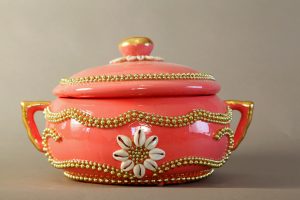
Noah Stommel
I am studying a soup tureen dedicated to the goddess Obba, wife of the thunder god Shango. This tureen is bright pink and is decorated with beads and cowrie shells in symmetrical patterns. This tureen is intended to symbolize the significance of a legend in which Obba was tricked into cutting off her ear by her co-wife, which she then served to Shango in a stew. Of course, rather than an ear in the tureen, traditional stones and cowrie shells would be placed inside to activate it. I am interested in finding out how this tureen is activated in context by people of Yoruba and Santeria faiths. Answering this question will help readers to understand the importance of key aspects of altar activation in Yoruba-inspired religions, as well as the value of the roles a tureen like this one might play in the lives of a dedicated Yoruba or Santeria practitioner.
Answers to these questions may emerge out of several of the class readings, including “The Yoruba World,” by Drewal, Pemberton, and Abiodun, which discusses the importance of Ase in activating art forms in Orisha religion. Ase is the life force possessed by every single thing in this world. Ultimately, “existence, according to Yoruba thought is dependent upon it; it is the power to make things happen and change” (Drewal, Pemberton & Abiodun, p. 16). Consequently, Ase has a big influence on the power of art in Orisha religion, as elaborated up in “Ase: Verbalizing and Visualizing Creative Power Through Art,” by Rowland Abiodun. Specifically related to my object of interest is a reading called “Face of the Gods: The Artists and Their Altars,” by Robert Farris Thompson, which cites an example of tureens symbolizing the presence of multiple orisha, given authority through the placement of stones and within the tureens themselves, similarly to the one in the museum.
In the library, I intend to find further sources to help me find the answer to the question of how this tureen is used by people of Yoruba and Santeria faiths, and how contextualization may influence activation and importance in honoring Obba. One source I intend to consult could be a catalogue of religious artifacts significant to Orisha religions of the Atlantic. Looking through such a catalogue would also give me insight into how similar items may be activated to be of religious significance. Films that investigate first-hand how these items are utilized would also be very valuable in discerning how Yoruba people and their descendants use tureens in their religion. Secondary sources would also be important for conducting research, as they provide an analysis of primary sources that could therefore be helpful for forming ideas. Articles and reviews on films or exhibits are great ways to gather a richer understanding of the items we are trying to learn more about.